Cover Story
AMBUSHED BY GREED
The Chaks of Baishari are a tiny community, the existence of which is being threatened by encroachment of their land to grow rubber and tobacco, in the name of development.
Philip Gain
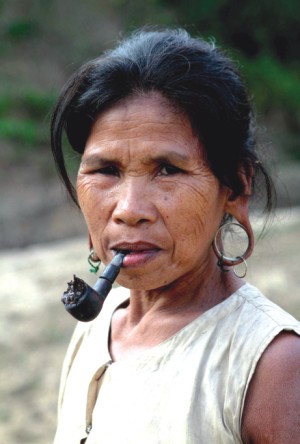 |
Chak woman in Badurjhiri. Photo: Philip Gain |
It's an exciting three-hour journey on foot from Baishari Chak Headmanpara to a real jungle village named Badurjhiri of 16 Chak families. On November 18, 2010, five of us–three Chaks and two of us from Dhaka–walk through the hills and streams, beauty and devastation with both joy and trepidation in our hearts.
As we walk out of the Chak paras (villages) in Baishari, the weather is calm and everything glistens under the golden sunlight of autumn. What fascinates the most as we walk through the Chak villages are the smiles of the Chaks and the look of the elderly women distinguished by their large earrings that stretch and distort their earlobes. Such large earrings and the wide earlobes are not to be found among women in any other ethnic community in Bangladesh. Another interesting scene is of the elderly women with tobacco pipes in their mouth blowing white smoke with an air of freedom.
One may wonder where these two strange places–Baishari and Badurjhiri–are. Both are located in Baishari Union in Naikhongchhari Upazila in Bandarban Hill District. Quite unknown even to regular trekkers to the Chittagong Hill Tracts (CHT), Baishari is one of four unions in Naikhongchhari Upazila with Chak habitation. There are around 3,000 Chaks in Bangladesh and another four to five thousand in Myanmar. There is no confirmed record of these beautiful people anywhere else on the globe. Imagine just seven thousand people in the whole world who have a distinct language and lifestyle! They proudly speak their language among themselves and find no difficulty speaking when communicating with their Bengali neighbours. They also speak Marma; but the Marmas, their close neighbours cannot speak the language of the Chak.
Leaving the Baishari Chak villages behind we get into the coolness of nature. Our feet dip into the cool stream water flowing over narrow, sandy, and shallow yellowish bed. Where does the water come from? “The water flows from the roots of trees that still survive and hold water from the rains,” is my naïve response to the query of my companion from Dhaka as regards to the source of the crystal clear cooling waters.
Dhung Cha Aung Chak (47), our host and guide, tells us it will take roughly three hours to walk to Badurjhiri and cautions us that we will pass through risky elephant habitat. He advises us to stay watchful. We are tense.
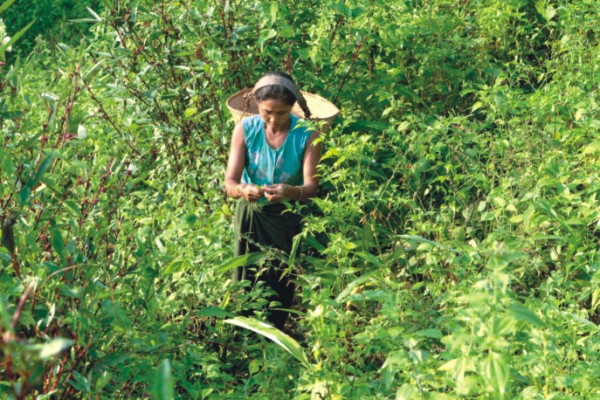 |
Chak woman at jum in Baishari. Photo: Philip Gain |
What shocks us shortly after leaving the Chak paras is the vast expanse of rubber monoculture beginning from the edge of the Chak villages and extending far into the southeast. From a distance its looks like a deep jungle. Mistake! As we walk through rows of rubber trees we feel it's a pure monoculture and a death-knell to wildlife. The rubber tree is an exotic species in this area and everywhere else in Bangladesh. It is a “milking” tree to its cultivators–most of them outsiders–who make a fast buck out of its cultivation. But for the Chaks and the Marmas, this is a 'bad development' on their traditional land. What used to be native forests, jum land, and grounds for their hunting and gathering is now rubber plantation. Bamboo, once an important source of livelihood and found in abundance, has been completely exhausted. This area also used to be an important habitat for elephants. The elephants still survive but in conflict with humans. Tree houses near paddy fields serve to keep the elephants away.
As we move forward, we walk about a kilometre along the stream of clear water flowing over yellowish sand. The cool water speaks of the tranquility of the surroundings. We are relaxed. However, as we look around we see the colossal damage done to nature and life. The hills, once covered with thick native forests, are bare today. Few are covered with ripe paddy, the last harvest of jumias, and which attracts elephants at night. The mention of elephants sends a chill down our spines. U Cha May Chak (37), wife of Dhung Cha who took the courage to be part of our exciting journey through the elephant habitat becomes particularly nervous as we see fresh marks of elephants' presence around. We walk fast to quickly pass through Garjanchhara and Rangajhiri to be on high ground and safe from elephants.
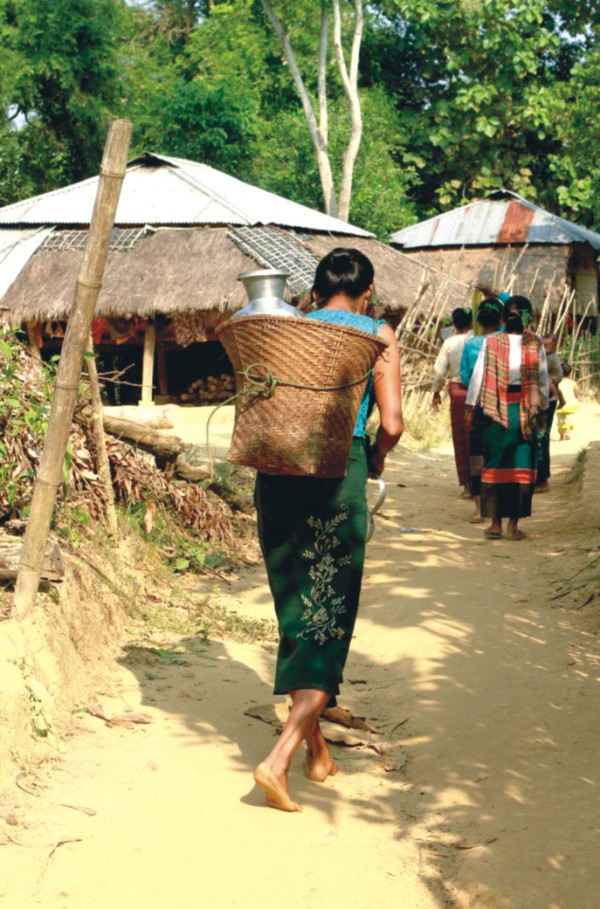 |
Chak village in Baishari. Photo: Philip Gain |
As we climb the hills, we stand on the top of complete destruction! The name of this place is Horinkhaiya. In every direction, the waves of hills are bare. As we look back to the northeast, the direction we came from, the vast expanse of low hills in the distance is covered with full-grown rubber trees. The hills in the distance look green and one can make the mistake of taking it as forests. In the south from Horinkhaiya, the rubber trees are hardly a year-old. Two years back [December 2008] when we passed through this area it was being cut for preparation of fresh rubber plantation. The nearby hills in the east, west and south still had coverage of native forests. Two years later we find the whole area cleared.
“Part of this area was cut last year,” says Dhung Cha Aung Chak. “This year preparation is going on for planting rubber trees.”
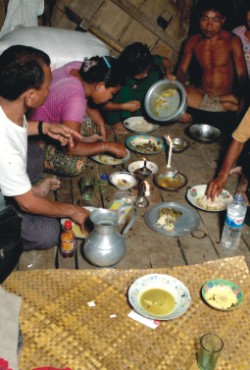 |
| Chak dining in Badurjhiri. Photo: Philip Gain |
Amrajhiri, an area that was still being cleared of vegetation in 2008 now has young rubber trees grown in terrace style farming on the steep hill slopes. A fence has been constructed to demarcate the rubber plantation area. As we look through rubber plantation into the east we see the greenery of some native forest patches.
Horinkhaiya and Amrajhiri are areas that used to be a safe haven for the Chaks and Marmas. They used to jum the land, hunt and gather freely. Edible plants and leaves still grow from the land devastated. U Cha May Chak (37) skillfully gathers a handful of succulent leaves of Usaithamang that will be part of our dinner menu tonight!
Into the forests!
Past Amrajhiri, we head for Badurjhiri, a small Chak village where we settle for the night. Now we see some greenery mixed up with patches of jum paddy on the high hills on the eastern horizon. As we go downhill we are thrilled at the absolute quietness and the narrow path through bushes. Ching La Mong Chak in the front of the line suddenly cries out in excitement. He has seen a red deer that disappears in the bush in the twinkle of an eye. I miss the deer; and caution Ching La Mong to stay calm the next time he sees any wildlife.
Before we reach Badurjhiri we walk past streams and bushes in fear. This is again an area where elephants pose threats to humans and domestic animals.
By the time we reach Badurjhiri, the sun is about to set. From a distance, the bamboo houses on the wooden platform in the small Chak hamlet look like dots in the greenery. A small stream flows beneath the village. The villagers have finished their washing, bathing, and day's collection of water. U Cha May Chak wastes no time in bathing in the cooling water. Dhung Cha Aung is busy collecting wild vegetables and herbs near the stream. We are yet to realise the value of his collection.
By the time we settle in the machang house (house built on platform) of our host A Thui Chak on the slope of hill, we are at ease. We stretch our legs on the wooden floor of the one-room house with a small storeroom and an open platform on one side. The four-feet high open space under the house is where the family stores its firewood and other household materials. The hanging platform is used for washing kitchen utensils and for drying clothes.
We are soon joined by Karbari Kijari Chak (55) and engage in a chat with our host and the karbari (hereditary head of a hamlet in the CHT, traditionally nominated by the villagers, formally appointed by the circle chiefs, and acknowledged by the administration). As we have just experienced and they tell us the hamlet of 15 Chak families in 280 No. Alikhyong Mouza is a real forest village and cut off from the nearest human habitation. To reach the nearest village and Baishari Bazar one has to walk for hours.
 |
Chak house in Badurjhiri.Photo: Philip Gain |
All 15 Chak families in the 30 year-old village are jumias. But nowadays they cannot completely rely on jum. “The crops we get from jum are good for a maximum of six months a year. For the rest of the year we depend on the harvest of bamboo, which has also been exhausted,” says Kijari Chak. “This situation has encouraged us to engage in tobacco cultivation to earn cash.”
In 2008 when we passed through this area to go to the Mru Village Chamuajhiri, a three-hour difficult walk into the southeast from Badurjhiri, there was no tobacco there. This time when we enter the village we see young tobacco plants on the flat land that the Chaks used for production of much needed crops.
At one time the Chaks of Badurjhiri were completely dependent on jum cultivation. And they grew enough cereals from jum and the cropland for the entire year, says the karbari.
“Eight Chak villages in Baishari union still depend on jum and those depending on jum constitute approximately 20 percent of the Chaks,” says Ching Ch La of Baishari Upar Chak Para. In total there are 21 Chak villages in Naikhongchhari, Baishari, Dochhari, and Bandarban unions–all in Naikhongchhari Upazila.
The Chaks have varied reactions to tobacco being brought to the area by British American Tobacco Company. The local people refer to it as Gold Leaf, which is actually a cigarette brand of the company. The company brings cash and chemical inputs (fertiliser and pesticides), the right incentives at a time when the villagers remain unemployed for months. “Tobacco has brought us employment for the months from November when villagers have no work. Those with no grains in store can at least buy food from the markets,” says Kijari.
|
Chak woman collecting vegetable from the wild. Photo: Philip Gain |
Elephants devouring paddy and damaging other crops are also a factor for taking an interest in tobacco. Elephants are not interested in tobacco. Elephants, the last major wildlife in the area the Chaks live in, oftentimes cause horror. In Early November 2010 elephants killed a buffalo of Badurjhiri Village. An elephant plunged its ivory three times into the stomach of the buffalo that remained tied at night. In the past elephants also killed a cow. According to the villagers of Badurjhiri there are herds of 50 to 100 elephants in the area.
The feared animal today, had enough to eat in the past. “Thirty years back, the area was a deep jungle,” says Kijari. “Man-animal fight was not like this in the past. Now the jungle is gone and the elephants go hungry and come to feed on our crops.”
Tobacco cultivation was introduced in Badurjhiri very recently in 2009 and this year 12 families are cultivating it. “Instant cash income is good from tobacco, which has expanded into the east from Badurjhiri,” says Thoai Ching Chak (30) of the village.
The Chaks of the Badurjhiri are awaiting a bigger threat that may come along with rubber cultivation. They have witnessed how rubber plantation dispersed the villagers of their neighbouring Chak village, Longoduhiri Chak Para. A Chak of Longodujhiri Chak Para, Shi Jai U Chak (40), now sheltered in Baishari Upar Chak Para, tells an appalling story of eviction of some 20 Chak families from his village that no longer exists.
Longodujhiri Chak Para was located in the northwest of Badurjhiri, about 30-minute walking distance. The village was evicted in 2002-2003. The Chak families lost their village to settlers who reportedly had R-holdings–“R” standing for refugee. One having R-holding is a settler getting land from the unclassed state forest (USF) potentially in the possession of the hill people.
“The outsiders have brought rubber on our jum land and village land and tobacco on cropland,” says Shi Jai U Chak saddened by the fact that he has become a daily labourer of a rubber plantation on land that was once the Chaks' jum, homesteads and garden land.
“In the past there was plenty of bamboo to harvest. The outsiders have cut them all. Now there is no bamboo for us to harvest,” laments Shi Jai. “Like all others in my village, I was a jum cultivator. After losing land, we, who still remain in the area, have become day labourers. Ten families have gone to Myanmar.”
“It is our bad luck that we could not protect our land. With R-holding in hand, the Bangali settlers now cultivate rubber and tobacco on our cropland,” laments Shi Jai.
Shi Jai and none of the Chak families of the Longodujhiri Chak Para ever had settlement on their land, which they as indigenous people of the soil, had cultivated and lived on for generations.
With three sons and three daughters Shi Jai has run into difficult a situation. He has become rootless and very poor.
Fearful of invasion of rubber, A Thui Chak (30) says, “If rubber cultivation comes close to our village, our situation will be like the Chaks of Longodujhiri. We will be evicted.”
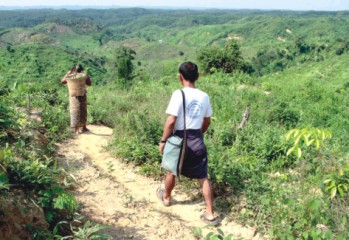 |
Bare hills in Baishari. Photo: Philip Gain |
In the candle-lit room we could continue our conversation all night but we are interrupted–it is time for dinner. As we are talking and sipping home-made [rice-brewed] beverage dochoani we do not forget to take note of the meticulous preparation of the dinner items [at the corner of the room] by our host family with the assistance of Dhung Cha Aung Chak and U Cha May Chak. We already have had the taste of the Chak Cuisine, a marvel in forest villages.
All that a Chak family in a forest village needs to prepare a tasteful and healthy dinner is a chicken; everything else comes from jum and the jungle. We had to pay for two chickens. One comes on our dinner menu. The preparation of two items–soup and salad is very simple. After slaughter the whole chicken is boiled enough in water to get the best out of it for preparation of a special soup. A sour leaf, kaibotak (in Chak language), collected from the jungle is the ingredient that makes it really delicious. A dash of garlic, onion, and ginger fried in hot cooking oil and mixed with the soup make one of the finest soups one can ever taste. Then the rest of the boiled chicken sliced and mixed with chillies' (special from jum), salt, bit of ginger and garlic makes an outstanding chicken salad. Two main items of a sumptuous dinner are ready.
Boiled for a minute or two, the green edible fern (Dhekisak) that Dhung Cha Aung Chak collected on our arrival at the Chak hamlet is to go with chilly paste. Chilly lovers will never forget the chilly paste the Chaks and other hill people make in basically two ways. One is, it is crushed in a piece of bamboo with a knot on one side (called maruthu in Chak language) with some dried fish or small prawn, salt, coriander, and lemon. Another preparation is that chilly is mashed and mixed with a particular eggplant grown in jum. A sour and soupy item made from tayongka (a sour leaf called Chupri shak in Bangla) and its flower with small prawn will add flavor and taste on your plate. Then there are boiled items–anything from banana bud to flower of silk-cotton tree. Don't be surprised if a salad of mere succulent banana plant and dried fish with lot of hot chilly comes as a side dish. It is safe and nourishing for your stomach. Once you sip the chicken soup with all these items, you will never forget your time in a forest village. These wonderful food items, made at such little cost, have tremendous cultural and traditional value. But alas! If rubber plantation invades the jum land of the Badurjhiri Chaks, the ingredients of Chak cuisine will be lost forever.
After dinner we continue our conversation with the karbari, members of our host family and some teenagers of Badurjhiri. There is no school in Badurjhiri Village. Children who want to go to school must reside at least in Baishari. In 2010 five children from Badurjhiri stayed in Baishari to go to school. This is a difficult choice for the families to send their children to schools in Baishari.
Mong Ching Thoai Chak (19) and Keo Keo Chak (18) are two teenagers from Baishari who have studied up to class three and five and then stopped. Both are now jumia. If jum stops in the area due to tobacco and rubber they are likely to become day labourers.
Preparation for construction of a road towards Badurjhiri is making progress. This is both good and bad news for the forest villagers. With road connections established the people can move quickly and improve their market access. However, even without roads and access of vehicles, the tobacco company, rubber entrepreneurs, and land grabbers have already gone up to Badurjhiri and further into the east. With road network expanded, outsiders will come in more easily. This is very bad news for the Chaks and Mru in the remote forest villages.
As night falls we go to sleep. Nine of us sleep on the floor of the machang house hardly 10 feet x 15 feet. No space in the house is wasted. But we feel we are sleeping in the lap of absolutely quiet nature.
Next morning we take time to see a nearby jum where the chilly and all other vegetables came from to our dinner plates. The jumias grow almost everything they need. And now towards the end of jum season, they are busy collecting what remains. We get fresh chilly, tayongkai and its mature flowers to carry to Dhaka.
When we leave Badurjhiri Village and the land of the Chaks, we see something unusual for the Chak village–many men entering the village with two sacks folded on two side of a piece of bamboo. They are carrying chemical fertilizer and storing it in their houses for use in the tobacco field. Some Chak families are busy plowing and preparing their land for tobacco. We realise the invasion of modern and destructive agriculture has already happened. This is a big threat for Badurjhiri.
Rubber and Tobacco–at whose Interest?
The Chaks, Marmas, and other local residents do not want rubber in particular on the hills. “The rubber cultivators from outside have taken control of almost all land in Amrajhiri, Battalijhiri, and Tang Mang Mangjojhiri in Alikhyong Mouza (no. 280),” reports Dhungcha Aung Chak. “We are protesting against rubber cultivation in our area. Bir Bahadur MP, chairman of Chittagong Hill Tracts Development Board (CHTDB) came here and gave us his word that nobody would be evicted and everybody will stay where they are. But we do not see the sign of halting rubber.”
“Rubber has invaded the whole Baishari area. Our people are not aware. We receive allegation that rubber plantation is sometimes carried out in collusion with the headmen,” says Bir Bahadur MP.
The chairman of the CHTDB does not see anything wrong in rubber cultivation. “But what is wrong is not doing it on the land leased for the purpose,” says the chairman annoyed at the anomalous behavior of the rubber cultivators. “We have cancelled lease of 500 rubber plots (593 according to a local journalist) in Bandarban Hill District alone. The reason is those who got lease for rubber left it fallow.”
According to ZuamLian Amlai, chairperson of Bandarban Chapter of Movement for the Protection of Forests and Land Right in the CHT, the leaseholders who had their leases cancelled in 2010 retrieved 77 plots within two months. He says that many others are trying to get back their leases.
Mong Mong Chak (61), a retired high official of the CHTDB agrees with the CHTDB chairman and sees rubber as an investment in the national interest. “I am for and against rubber,” says Mong Mong Chak who comes from Baishari. “We, the Chaks have lost our land for our foolishness. We did not apply for participation in rubber.”
Mong Mong Chak is also resentful about the government authority assigned to oversee rubber plantation. “The government and the standing committee charged with rubber cultivation did not think about our well-being. It was the government policy to bring outsiders who have taken our land in the name of development.”
According to Mong Mong Chak, the leases for rubber done before the peace accord in 1997 stay valid and those who did not cultivate rubber are supposed to have their leases cancelled. “Some leases have been cancelled on paper, not in reality. There is no scope to lease land for rubber after the peace accord. Leases, if given after the peace accord, are illegal,” says Mong Mong Chak.
The Bandarban Hill District Council that is supposed to authorise any lease for rubber cultivation remains in the dark regarding on-going rubber cultivation in its jurisdiction.
Kyaw Shwe Hla, its chairman says, “We are yet to find out the status of rubber plantation–what plots have been cancelled and who are carrying out rubber plantation nowadays. All that we know is leases of some plots cancelled on paper may have gone to the same lease holders. The Bandarban Hill District Council did not authorise granting or cancelling leases.”
“We have written to the district administration to provide us information about the status of rubber plantation. We are yet to get an answer to our queries,” says Hla. “We are unable to do anything with land. What we see is many companies and individuals from outside are buying leases from the local people and taking possession of land.”
Land for rubber plantation and horticulture in Bandarban comes under the jurisdiction of three authorities–the Chittagong Hill Tracts Development Board (CHTDB), Deputy Commissioner, and the Standing Committee. The CHTDB oversees the rubber cultivation on 2,000 acres of land leased to 500 households under a rehabilitation project. These families are supposed to get land titles in their names.
A much bigger amount of land–nearly 50,000 acres–has been reportedly leased to around 1,800 individuals for commercial rubber production and horticulture. The size of an individual plot is generally 25 acres (some are up to 100 acres). The records related to the status of rubber plantation and horticulture is very difficult to get. However, what can be figured at from available records (partial) is that the majority of the individual leaseholders come from outside of Bandarban and a big percentage never initiated rubber cultivation after getting lease of land. Such lands have become grounds for anomalies and outsiders (individuals and companies) are taking advantage of this loophole.
Philip Gain is director of Society for Environment and Human Development (SEHD) and freelance journalist.
Copyright
(R) thedailystar.net 2010 |
